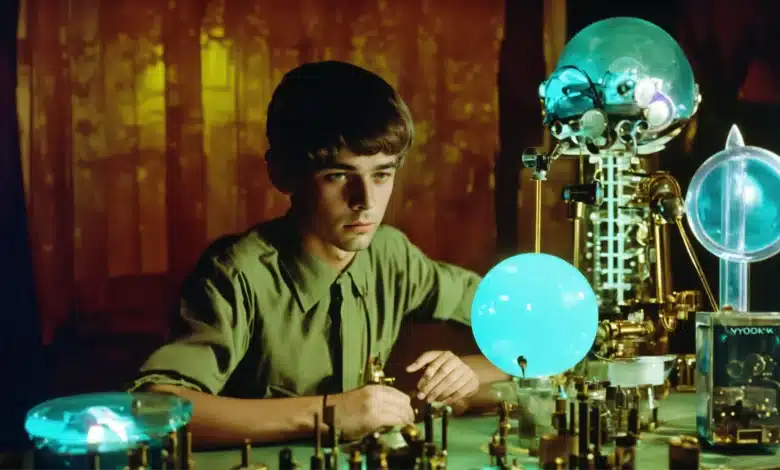The 1982 Movie Poltergeist Used Real Skeletons as Props: An Eerie Truth Unveiled – Tymoff

Introduction
The 1982 movie Poltergeist used real skeletons as props, creating an eerie atmosphere that has intrigued horror fans and film historians alike. Directed by Tobe Hooper and produced by Steven Spielberg, Poltergeist is renowned not only for its spine-chilling storyline but also for the unsettling revelation that real human skeletons were used during the filming. This macabre detail has contributed to the film’s enduring legacy and has sparked numerous discussions and speculations over the years.
The Birth of Poltergeist: A Horror Classic
Poltergeist, released in 1982, quickly became a seminal horror film, captivating audiences with its tale of a suburban family haunted by malevolent spirits. The film’s realistic effects and terrifying sequences were groundbreaking for its time. However, the 1982 movie Poltergeist used real skeletons as props, adding an unexpected layer of authenticity to the horror.
The Decision to Use Real Skeletons
The decision to use real skeletons in Poltergeist was driven by practicality and cost. At the time, real skeletons were cheaper to obtain than realistic plastic models. This controversial choice, however, has become one of the most talked-about aspects of the film. The 1982 movie Poltergeist used real skeletons as props to achieve a level of realism that artificial models couldn’t provide.
Filming the Infamous Pool Scene
One of the most infamous scenes in Poltergeist involves the character Diane Freeling, played by JoBeth Williams, being dragged into a muddy pool filled with skeletons. Unbeknownst to her at the time, these skeletons were real. The 1982 movie Poltergeist used real skeletons as props in this scene, intensifying the terror for both the actors and the audience.
Impact on the Cast and Crew
The use of real skeletons had a profound impact on the cast and crew. JoBeth Williams later revealed her shock upon discovering the truth. The 1982 movie Poltergeist used real skeletons as props, which added a genuine sense of dread to the filming process. This revelation has since become a pivotal part of the film’s lore.
The Curse of Poltergeist: Fact or Fiction?
The eerie choice to use real skeletons has often been linked to the so-called “Poltergeist Curse.” Several cast members experienced untimely deaths and strange occurrences after the film’s release. The 1982 movie Poltergeist used real skeletons as props, fueling the belief that the film was cursed. While some dismiss this as mere superstition, it remains a compelling part of the Poltergeist story.
Ethical Concerns and Hollywood Practices
The use of real skeletons in Poltergeist raises ethical questions about Hollywood practices. The 1982 movie Poltergeist used real skeletons as props, highlighting a time when the film industry often prioritized realism over ethical considerations. This practice has since been widely criticized and is no longer common in modern filmmaking.
Audience Reactions and Legacy
Audiences were largely unaware of the use of real skeletons at the time of the film’s release. However, as this fact became more widely known, it added to the film’s mystique. The 1982 movie Poltergeist used real skeletons as props, which has since become a legendary aspect of the film, contributing to its status as a classic in the horror genre.
Behind-the-Scenes Revelations
Over the years, behind-the-scenes stories from the making of Poltergeist have surfaced, providing insight into the decision-making process. The 1982 movie Poltergeist used real skeletons as props, a decision that has been both condemned and defended by various members of the film’s production team. These revelations offer a glimpse into the complexities of creating a horror masterpiece.
Influence on Modern Horror Films
The influence of Poltergeist on modern horror films cannot be overstated. The 1982 movie Poltergeist used real skeletons as props, setting a precedent for authenticity in horror filmmaking. While the ethical standards have evolved, the quest for realism initiated by Poltergeist continues to inspire filmmakers today.
Reflecting on Poltergeist’s Enduring Impact
Reflecting on the enduring impact of Poltergeist, it’s clear that the film’s use of real skeletons has become an indelible part of its legacy. The 1982 movie Poltergeist used real skeletons as props, creating a sense of realism that still resonates with audiences. This controversial choice remains a topic of fascination and discussion among horror enthusiasts and film scholars.
Conclusion
The 1982 movie Poltergeist used real skeletons as props, a decision that has left an indelible mark on the film and its legacy. This choice, while controversial, contributed to the film’s eerie atmosphere and has since become a defining element of its history. Poltergeist’s impact on the horror genre is undeniable, and the story behind its use of real skeletons continues to captivate and horrify fans to this day.
FAQs
1.Why did the filmmakers decide to use real skeletons in Poltergeist?
The 1982 movie Poltergeist used real skeletons as props because they were cheaper and more realistic than plastic models at the time.
2.How did the cast react to the use of real skeletons?
Many cast members, including JoBeth Williams, were unaware that real skeletons were being used during filming and were shocked upon discovering the truth.
3.Is there any truth to the Poltergeist Curse?
The 1982 movie Poltergeist used real skeletons as props, and several cast members experienced tragic events, leading to rumors of a curse. While intriguing, these claims remain speculative.
4.Are real skeletons still used in movies today?
Modern ethical standards and advances in special effects have made the use of real skeletons in films uncommon. The 1982 movie Poltergeist used real skeletons as props, but this practice has largely been abandoned.
5.What is the legacy of Poltergeist in the horror genre?
Poltergeist remains a seminal horror film, partly due to its use of real skeletons. The 1982 movie Poltergeist used real skeletons as props, setting a precedent for authenticity that continues to influence horror filmmakers




